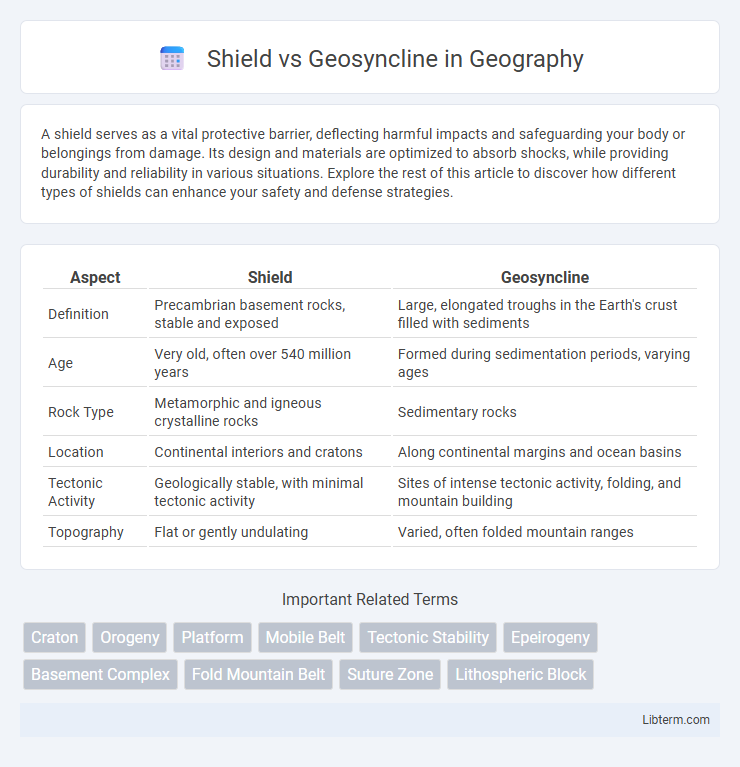A shield serves as a vital protective barrier, deflecting harmful impacts and safeguarding your body or belongings from damage. Its design and materials are optimized to absorb shocks, while providing durability and reliability in various situations. Explore the rest of this article to discover how different types of shields can enhance your safety and defense strategies.
Table of Comparison
| Aspect | Shield | Geosyncline |
|---|---|---|
| Definition | Precambrian basement rocks, stable and exposed | Large, elongated troughs in the Earth's crust filled with sediments |
| Age | Very old, often over 540 million years | Formed during sedimentation periods, varying ages |
| Rock Type | Metamorphic and igneous crystalline rocks | Sedimentary rocks |
| Location | Continental interiors and cratons | Along continental margins and ocean basins |
| Tectonic Activity | Geologically stable, with minimal tectonic activity | Sites of intense tectonic activity, folding, and mountain building |
| Topography | Flat or gently undulating | Varied, often folded mountain ranges |
Introduction to Shields and Geosynclines
Shields are large, stable areas of exposed Precambrian crystalline igneous and metamorphic rocks forming the core of continents, characterized by minimal tectonic activity and long geological stability. Geosynclines are extensive linear troughs or basins that accumulate thick sequences of sediments over time, often serving as sites for future mountain building through tectonic compression and folding. Understanding the contrasting roles of shields as ancient continental nuclei and geosynclines as sedimentary basins helps explain the dynamic processes shaping Earth's lithosphere.
Definition and Key Characteristics of Shields
Shields are large, stable areas of exposed Precambrian crystalline igneous and metamorphic rocks that form the ancient cores of continents, distinguished by their flat or gently undulating topography. Unlike geosynclines, which are vast, elongated trough-like depressions filled with sedimentary layers and subject to folding and mountain-building processes, shields exhibit minimal tectonic activity and deformation. Their key characteristics include high seismic stability, low heat flow, and extensive erosion that exposes deep crustal rocks at the surface.
Definition and Key Characteristics of Geosynclines
Geosynclines are large-scale, elongated troughs or downwarps in the Earth's crust filled with thick sedimentary layers, often associated with tectonic plate convergence and mountain-building processes. These structures are characterized by significant subsidence, intense sediment accumulation, and folding caused by compressional forces. Unlike shields, which are stable, ancient, and crystalline basement rocks, geosynclines represent dynamic, often younger regions of crustal deformation and sedimentation.
Geological Formation Processes
Shields are ancient, stable crustal regions composed primarily of Precambrian crystalline basement rocks, formed through long-lasting processes of metamorphism and igneous activity. Geosynclines develop as elongated troughs in the Earth's crust where thick sediment accumulation and tectonic compression lead to folding, faulting, and eventual mountain building. The contrast in formation processes highlights shields as foundational continental cores, while geosynclines represent dynamic zones of sedimentation and orogenic activity.
Distribution of Shields and Geosynclines Worldwide
Shields are extensive, stable Precambrian rock formations primarily found in regions such as the Canadian Shield, the Brazilian Shield, and the African Shield, forming the ancient cores of continents. Geosynclines are large-scale linear troughs filled with sediments and volcanic materials, predominantly located along continental margins, including the Pacific Ring of Fire and the Appalachian geosyncline. The global distribution shows shields concentrated in continental interiors, while geosynclines occur mainly in tectonically active areas, influencing mountain-building processes.
Rock Types and Structures Associated
Shields are composed predominantly of ancient, stable crystalline basement rocks such as granite and gneiss that form broad, flat expanses with minimal folding. Geosynclines consist chiefly of sedimentary rock sequences interspersed with volcanic deposits, characterized by extensive folding, faulting, and sediment accumulation in trough-like structures. The structural emphasis in shields is on rigid, stable platforms, while geosynclines exhibit dynamic deformation and stratified layering indicative of active sedimentary basins.
Tectonic Significance and Evolution
Shields represent stable, ancient cratonic cores composed predominantly of Precambrian crystalline rocks, reflecting prolonged tectonic stability and minimal deformation. Geosynclines are large-scale downwarped sedimentary basins that accumulate thick sequences of sediments and eventually undergo orogenic processes, playing a critical role in mountain-building cycles. The tectonic evolution of shields involves long-term lithospheric stabilization, whereas geosynclines evolve through subsidence, sedimentation, and subsequent orogeny, marking active phases of crustal deformation and plate convergence.
Economic Importance: Minerals and Resources
Shields contain some of the world's richest mineral deposits, including gold, diamonds, and iron ore, making them critical for mining industries and economic development. Geosynclines, as ancient sedimentary basins, often hold significant fossil fuel reserves such as oil and natural gas, contributing substantially to energy resources. Both geological structures play a vital role in providing minerals and hydrocarbons essential for industrial growth and global markets.
Shields vs Geosynclines: Key Differences
Shields are large, stable areas of exposed Precambrian crystalline rocks that form the foundations of continents, whereas geosynclines are elongated troughs filled with sedimentary and volcanic materials often associated with mountain-building processes. Shields represent tectonically inactive, rigid crustal regions, contrasting with geosynclines that experience significant subsidence and deformation due to active plate tectonics. The primary difference lies in geological stability: shields are ancient, stable continental cores, while geosynclines are dynamic zones prone to orogeny and crustal thickening.
Conclusion and Future Research Directions
Shield regions provide stable, ancient crystalline basement rocks with minimal tectonic activity, whereas geosynclines represent tectonically active sedimentary basins prone to orogenic processes. Future research should emphasize high-resolution geochronology and geophysical imaging to refine the temporal and structural evolution of these geological features. Integrating isotopic analyses and 3D geodynamic modeling will enhance understanding of crustal formation and the interplay between stable shields and evolving geosynclines.
Shield Infographic

 libterm.com
libterm.com